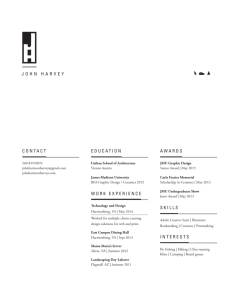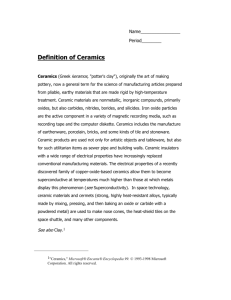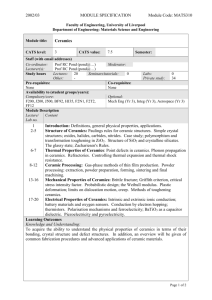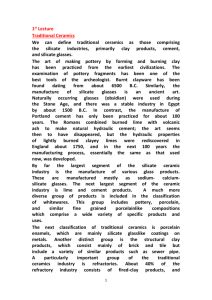421bcMODULE IV - Notes Milenge
advertisement
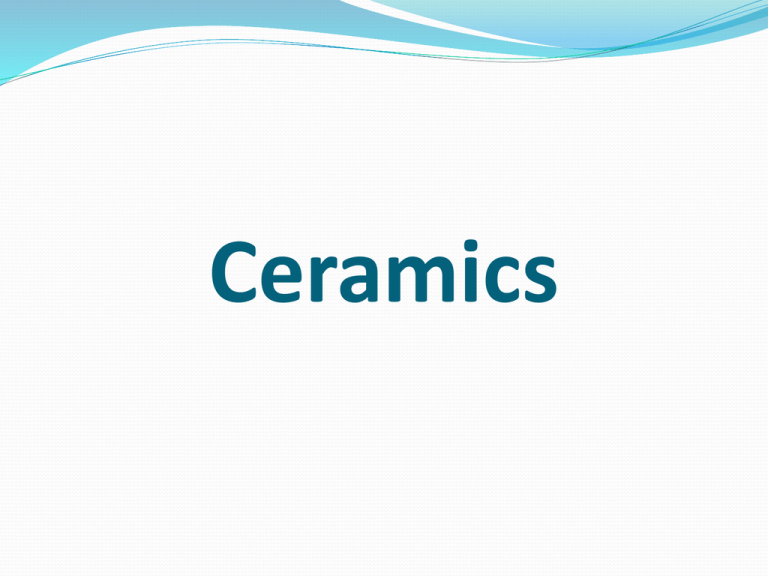
Ceramics Ceramic Ceramic materials are compounds of metallic and nonmetallic elements (often in the form of oxides, carbides, and nitrides) and exist in a wide variety of compositions and forms. The American Ceramic Society has defined ceramic products as those manufactured" by the action of heat on raw materials, most of which are of an earthy nature (as distinct from metallic, organic etc.) while of the constituents of these raw materials, the chemical element silicon, together with its oxide and the compounds thereof (the silicates), occupies a predominant position." Contd… Most have crystalline structures, but unlike metals, the bonding electrons are generally captive in strong ionic or covalent bonds. The absence of free electrons makes the ceramic materials poor electrical conductors and results in many being transparent in thin sections. Because of the strength of the primary bonds, most ceramics have high melting temperatures. Ceramic articles of industry are : Dinner ware, electrical and chemical porcelain, refractory bricks and tiles, glass, porcelain enamels, abrasives, cutting tools, bricks and tiles, cements and concretes, whitewares, mineral Ores, slags and fluxes and insulators etc. Contd… Classification of Ceramics Functional Classification of Ceramics Abrasives Pure Oxide Ceramics Fire Clay Products Inorganic glasses Cementing materials Rocks Minerals Refractories Classification of Ceramics Structural Classification of Ceramics Crystalline Non Crystalline Glass bonded Cements Classification of Ceramics Whitewares Bricks and tiles Porcelin enamel Cements and concrete Abrasives Glass Refractories Slags and Fluxes Properties of Ceramics The co-valent bonding of ceramic materials, alongwith their high melting point and relative resistance to oxidation, make ceramics good candidates for high temperature applications. In addition, they are relatively cheap and abundant and are not dependent on import for supply. Many ceramics retain strength to much higher temperatures than metals. There being virtual absence of ductility in ceramics, so, in general, they can not be machined or built up from stock. Contd… In general, ceramics are hard, brittle and high melting point materials with : desirable electrical, magnetic and optical properties, i.e., low electrical and thermal conductivity. good chemical and thermal stability, that is, high hot-strength and high corrosion resistance, and freedom from oxidation. good creep resistance, and High compressive strength and excellent resistance to wear. Their low density is also an attractive feature to minimise centrifugal stresses in parts rotating at high speed. PRODUCT APPLICATIONS 1. Clay products : Clay body ceramics include whitewares and stoneware. Whitewares includes such families of products as earthenwares, China and porcelain. Whitewares are largely used as tile, sanitary ware, low and high voltage insulators, and high frequency applications. Stoneware applications are : Glazed pipes, roofing tiles and tableware. 2. Refractories Refractory ceramics are the materials which are capable of withstanding high temperature in various situations. The refractory materials are of three types. Acidic refractories are based on alumina-silica composition, varying from pure silica to nearly pure alumina, through a wide range of alumina silicates. The basic constituent of basic refractories is magnesia, MgO. Basic refractories include chrome-magnesite, dolomite, limestone and magnesite. Neutral refractories include substances which do not combine with either acidic or basic oxides. With increasing alumina content, silica-alumina refractories may gradually change from an acidic to neutral type. A typical neutral character is exhibited by such refractories as Carbon, graphite, carbide, chromite, bauxite and forsterite. Contd… Refractories are used in the construction or lining of furnaces, boilers, flues, regenerators, convertors, crucibles, dryers, pyrometer tubes and in many others, primarly to withstand the high temperature. Al2O3 The most widely used oxide refractory ceramic is alumina . It is sintered into cutting tool bits, spark plug insulators, high temperature tubes, melting crucibles, wear components and substrates for electronic circuits and resistors. 3.Electrical and Magnetic Applications Ceramics find wide applications in electrical and electronic industries. As insulators, semi-conductors, dielectrics, ferroelectrics, piezoelectric crystals. Ceramics such as glass, porcelain, alumina, quartz and mica, are getting heavy demands. Ceramics, such as SiC, are used as resistors and heating elements for furnaces. Ceramics, having semiconducting properties, are used for thermistors and rectifiers. Barium titantate, for example, is used in capacitors and transducers. 4. Optical Applications Ceramics are notably useful as a pigment, because it is exceptionally durable. It is completely oxidised and not subject to chemical attack and variation. Yttralox (a new ceramic material) is useful in optical appIications, becuase it is as transparent as window glass and can resist very high temperature. Yttralox is completely free from pores. Generally, Ceramics are opaque, because of the presence of tiny pores within them that scatter light. 5. Phosphorescence Ceramic phosphors emit light of a characteristic wavelength when excited or pumped by some appropriate energy source (an electric discharge or electron beam). Light tubes, VDT's and colour T.V. rely on this phenomenon. Of increasing interest are Laser materials, The most widely used Laser is ruby (an Al2O3 , crystal doped with Cr ions). They are being used for machining, welding and cutting etc. Glass Glasses are, by definition, "Ceramics" because the starting materials needed to produce glass are typical of ceramic materials. However, they are produced by the melt processing route, instead of the powder metallurgy route used for other ceramics. In ceramic science, the word "glass" signifies any amorphous component of ceramic mixture. However, in general terms, glass is a transparent silica product which may be amorphous or crystalline, depending on heat treatment. Glasses may be either inorganic or organic. Contd… Vitreous materials or inorganic glasses are the fusion products which during solidification from a liquid state failed to crystallise. During the cooling process, the glasses exhibit no discontinuous change at any temperature and only a progressive increase in viscosity is noticed. In fact, glass is a hard liquid. Glass Forming Constituents : Silica, which is obtained from high-purity silica sand is the most widely used glassforming constituent. Other glass forming constituents are the oxides of boron, vanadium, germanium and phosphorous. Some other elements and compounds such as tellurium, selenium and BeF2 can also form glasses. Contd… Along with oxides, fluxes are also added to the charge for a glass. Fluxes lower the fusion temperature of the glass and render the molten glass workable at reasonable temperature. However, fluxes may reduce the resistance of glass to chemical attack, render it water soluble or make it subject to partial or complete devitrification (that is, crystallisation) upon-cooling; Such a glass is undesirable since the crystalline are extremely weak and brittle. Stabilizers are therefore, added to the glass batch to overcome these problems. Ploymers & Plastics Plastics or polymer Definition: A group of engineered materials characterized by large molecules that are built up by the joining of smaller molecules. They are natural or synthetics resins. Properties of plastics Light weight Good resistance to corrosion Easy of fabrication into complex shapes Low electrical and thermal conductivity Good surface finish Good optical properties Good resistance to shock and vibration. Classification – Polymers Classification based on their industrial usage: (a) plastics and (b) elastomers. Classification based on their temperature dependence: (a) thermoplasts and (b) thermosets The End



